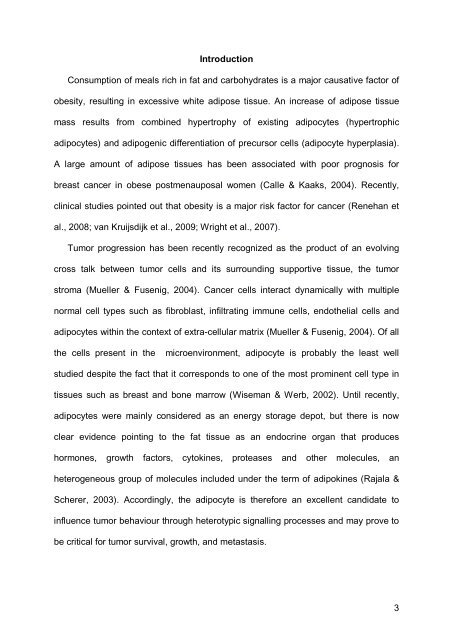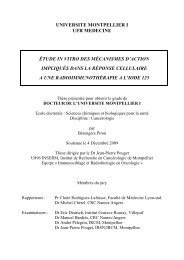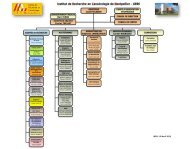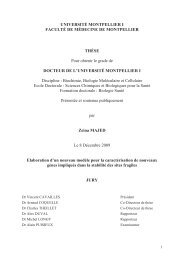Intro<strong>du</strong>ctionConsumption of meals rich in fat and carbohydrates is a major causative factor ofobesity, resulting in excessive white adipose tissue. An increase of adipose tissuemass results from combined hypertrophy of existing adipocytes (hypertrophicadipocytes) and adipogenic differentiation of precursor cells (adipocyte hyperp<strong>la</strong>sia).A <strong>la</strong>rge amount of adipose tissues has been associated with poor prognosis forbreast cancer in obese postmenauposal women (Calle & Kaaks, 2004). Recently,clinical studies pointed out that obesity is a major risk factor for cancer (Renehan <strong>et</strong>al., 2008; van Kruijsdijk <strong>et</strong> al., 2009; Wright <strong>et</strong> al., 2007).Tumor progression has been recently recognized as the pro<strong>du</strong>ct of an evolvingcross talk b<strong>et</strong>ween tumor cells and its surrounding supportive tissue, the tumorstroma (Mueller & Fusenig, 2004). <strong>Cancer</strong> cells interact dynamically with multiplenormal cell types such as fibrob<strong>la</strong>st, infiltrating immune cells, endothelial cells andadipocytes within the context of extra-cellu<strong>la</strong>r matrix (Mueller & Fusenig, 2004). Of allthe cells present in the<strong>micro</strong>environment, adipocyte is probably the least wellstudied <strong>de</strong>spite the fact that it corresponds to one of the most prominent cell type intissues such as breast and bone marrow (Wiseman & Werb, 2002). Until recently,adipocytes were mainly consi<strong>de</strong>red as an energy storage <strong>de</strong>pot, but there is nowclear evi<strong>de</strong>nce pointing to the fat tissue as an endocrine organ that pro<strong>du</strong>ceshormones,growth factors, cytokines, proteases and other molecules, anh<strong>et</strong>erogeneous group of molecules inclu<strong>de</strong>d un<strong>de</strong>r the term of adipokines (Raja<strong>la</strong> &Scherer, 2003). Accordingly, the adipocyte is therefore an excellent candidate toinfluence tumor behaviour through h<strong>et</strong>erotypic signalling processes and may prove tobe critical for tumor survival, growth, and m<strong>et</strong>astasis.3
The aspartic protease cathepsin D (cath-D), a marker of poor prognosis in breastcancer (Ferrandina <strong>et</strong> al., 1997; Foekens <strong>et</strong> al., 1999; Rochefort, 1992; Rodriguez <strong>et</strong>al., 2005; Westley & May, 1999), is overexpressed and secr<strong>et</strong>ed at high levels byhuman epithelial breast cancer cells (Capony <strong>et</strong> al., 1987; Capony <strong>et</strong> al., 1989;Liaud<strong>et</strong>-Coopman <strong>et</strong> al., 2006; Rochefort & Liaud<strong>et</strong>-Coopman, 1999; Westley &Rochefort, 1980). Cath-D stimu<strong>la</strong>tes cancer cell proliferation, fibrob<strong>la</strong>st outgrowth,angiogenesis and m<strong>et</strong>astasis (Berchem <strong>et</strong> al., 2002; Fusek & V<strong>et</strong>vicka, 1994; Garcia<strong>et</strong> al., 1990; Glon<strong>du</strong> <strong>et</strong> al., 2001; Glon<strong>du</strong> <strong>et</strong> al., 2002; Hu <strong>et</strong> al., 2008; Laurent-Matha<strong>et</strong> al., 2005; Liaud<strong>et</strong> <strong>et</strong> al., 1995; Liaud<strong>et</strong> <strong>et</strong> al., 1994). Here, we investigated theexpression of cath-D in obese adipocytes and its role in the control of adipogenesis.We show that cath-D expression is up-regu<strong>la</strong>ted in human and mouse obese adipos<strong>et</strong>issues as well as <strong>du</strong>ring adipogenesis. Moreover, we <strong>de</strong>monstrate that cath-Dpositively controls the adipogenic process.ResultsCath-D transcription is up-regu<strong>la</strong>ted in human and mouse obese adipos<strong>et</strong>issuesBecause of the recently established re<strong>la</strong>tionship b<strong>et</strong>ween obesity and cancerinci<strong>de</strong>nce (Renehan <strong>et</strong> al., 2008; van Kruijsdijk <strong>et</strong> al., 2009; Wright <strong>et</strong> al., 2007) andof the <strong>de</strong>monstrated role of cath-D in both cancer cells and stromal cells (Liaud<strong>et</strong>-Coopman <strong>et</strong> al., 2006), we investigated cath-D expression in human and mouseadipose tissues.Cath-D mRNA expression was examined in human intra-abdominal viscera<strong>la</strong>dipose tissue (VAT) from lean and obese human (Fig. 1A, panel a). Interestingly,cath-D mRNA was significantly increased in human obese visceral adipose tissue4
- Page 1 and 2:
Université Montpellier I UFR Méd
- Page 3 and 4:
Un grand merci à tous mes collabor
- Page 5 and 6:
TitleBreast cancer and tumoral micr
- Page 7 and 8:
Cancer du sein et micro-environneme
- Page 9 and 10:
C. PRESENTATION DU TRAVAIL DE THESE
- Page 11 and 12:
But de la thèseLa cathepsine-D (ca
- Page 13 and 14:
I. Le tissu adipeux1) Généralité
- Page 15 and 16: (Adenosine triphosphate). Cette pro
- Page 18 and 19: Cette synthèse de novo a lieu dans
- Page 20 and 21: ABFigure 6 : Schéma de la oxydati
- Page 22 and 23: d. Ladipocyte : une cellule sécré
- Page 24 and 25: 3) Ladipogenèsea. Les différentes
- Page 26 and 27: . Les facteurs de transcriptionLa d
- Page 28 and 29: Lexpression de C/EBP est quant à e
- Page 30 and 31: adipeux. Les analyses histologiques
- Page 32 and 33: adipocyteFigure 10 : Schéma repré
- Page 34 and 35: II. La cathepsine-D1) Synthèse, ma
- Page 36 and 37: les cath-B et L, en une forme matur
- Page 38 and 39: Il existe deux RM6P : le RM6P/IGFII
- Page 40 and 41: 2) Fonctions de la cath-Da. Dans la
- Page 42 and 43: . Dans les pathologiesEn plus de se
- Page 44 and 45: c. Rôles et mécanismes daction da
- Page 46 and 47: carcinome de prostate serait respon
- Page 48 and 49: La cath-D joue donc un rôle import
- Page 50 and 51: Une fois le marquage des peptides e
- Page 52 and 53: Afin de réaliser ce projet, nous a
- Page 54 and 55: III. Le récepteur LRP11) Organisat
- Page 56 and 57: 2) Trafic intra-cellulaireComme le
- Page 58 and 59: LRP1αLRP1Membrane associatedprotea
- Page 60 and 61: Tableau 3 : Ligands connus du LRP1(
- Page 62 and 63: I. Etude du rôle de la cathepsine
- Page 64 and 65: Cathepsin-D, a key protease in brea
- Page 68 and 69: (Fig. 1A, panel a). This differenti
- Page 70 and 71: differentiated adipocyte (Fig. 4B).
- Page 72 and 73: DiscussionOur results demonstrate t
- Page 74 and 75: from normal and peri-al breast adip
- Page 76 and 77: mouse RS9 (sens 5CGGCCCGGGAGCTGTTGA
- Page 78 and 79: agreement of local ethic committee.
- Page 80 and 81: Statistical analysis. Results are e
- Page 82 and 83: Loncarek J, Freiss G, Vignon F and
- Page 84 and 85: Aa3000 *b4000*B8000**cath-D mRNA(ar
- Page 86 and 87: ABcath-D mRNA(ratio RS9)PPARg mRNA(
- Page 88 and 89: A D3 D7 D14D0BaD0 D3 D7 D14D0 D3 D7
- Page 90 and 91: AshLucshcath-DF442A C34 C37 A4 D10c
- Page 92 and 93: AF442-AC34C37A4D10BF442-AC34C37A4D1
- Page 94 and 95: II. Etude du rôle du LRP1 dans les
- Page 96 and 97: 2) Article 2:LRP1 receptor controls
- Page 98 and 99: LRP1, Adipogenesis, Obesityrelative
- Page 100 and 101: LRP1, Adipogenesis, ObesityFigure 3
- Page 102 and 103: LRP1, Adipogenesis, ObesityFigure 5
- Page 104 and 105: LRP1, Adipogenesis, ObesitySome ins
- Page 106 and 107: LRP1, Adipogenesis, ObesityLipolysi
- Page 108 and 109: CONCLUSIONLa cathepsine D (cath-D)
- Page 110 and 111: la souris obèses. Enfin, linhibiti
- Page 112 and 113: carcinogénique sont encore mal con
- Page 114 and 115: Ce travail de thèse a étudié, po
- Page 116 and 117:
REFERENCESAhima, R. S. (2006). Adip
- Page 118 and 119:
implicates them as antigen presenti
- Page 120 and 121:
Cataldo, A. M., Barnett, J. L., Ber
- Page 122 and 123:
Folkman, J. (2003). Fundamental con
- Page 124 and 125:
Hofmann, S. M., Zhou, L., Perez-Til
- Page 126 and 127:
Langin, D. (2006a). Adipose tissue
- Page 128 and 129:
Ludwig, T., Ovitt, C. E., Bauer, U.
- Page 130 and 131:
Nirde, P., Derocq, D., Maynadier, M
- Page 132 and 133:
Rozanov, D. V., Hahn-Dantona, E., S
- Page 134 and 135:
Taleb, S., Cancello, R., Clement, K
- Page 136 and 137:
Xiao, Y., Junfeng, H., Tianhong, L.
- Page 138 and 139:
F. ANNEXE98
- Page 140 and 141:
Cathepsin D is a new ligand for ext
- Page 142 and 143:
INTRODUCTIONLysosomal aspartic prot
- Page 144 and 145:
pcDNA3.1(+)Myc-tagged LRP1b into pc
- Page 146 and 147:
(Protein refolding kit, Novagen) fo
- Page 148 and 149:
anti-mouse-gold (Aurion). Sections
- Page 150 and 151:
not secrete detectable levels of pr
- Page 152 and 153:
using cath-D-/- MEF transfected wit
- Page 154 and 155:
co-culture outgrowth assays with ca
- Page 156 and 157:
REFERENCES1. Vignon, F., Capony, F.
- Page 158 and 159:
steps in vivo: proliferation, angio
- Page 160 and 161:
28. Laurent-Matha, V., Lucas, A., H
- Page 162 and 163:
42. Zurhove, K., Nakajima, C., Herz
- Page 164 and 165:
Figure 1. Cath-D interacts with the
- Page 166 and 167:
Figure 2. Cath-D binds to residues
- Page 168 and 169:
Figure 3. Cath-D interacts with LRP
- Page 170 and 171:
Figure 5. Silencing LRP1 in cath-D
- Page 172 and 173:
Figure 1. Cath-D interacts with the
- Page 174 and 175:
Figure 6. LRP1 is the receptor medi
- Page 176 and 177:
Beaujouin, Figure Sup. 2cath-D-/-ME
- Page 178:
RésuméLaspartyl protéase catheps





